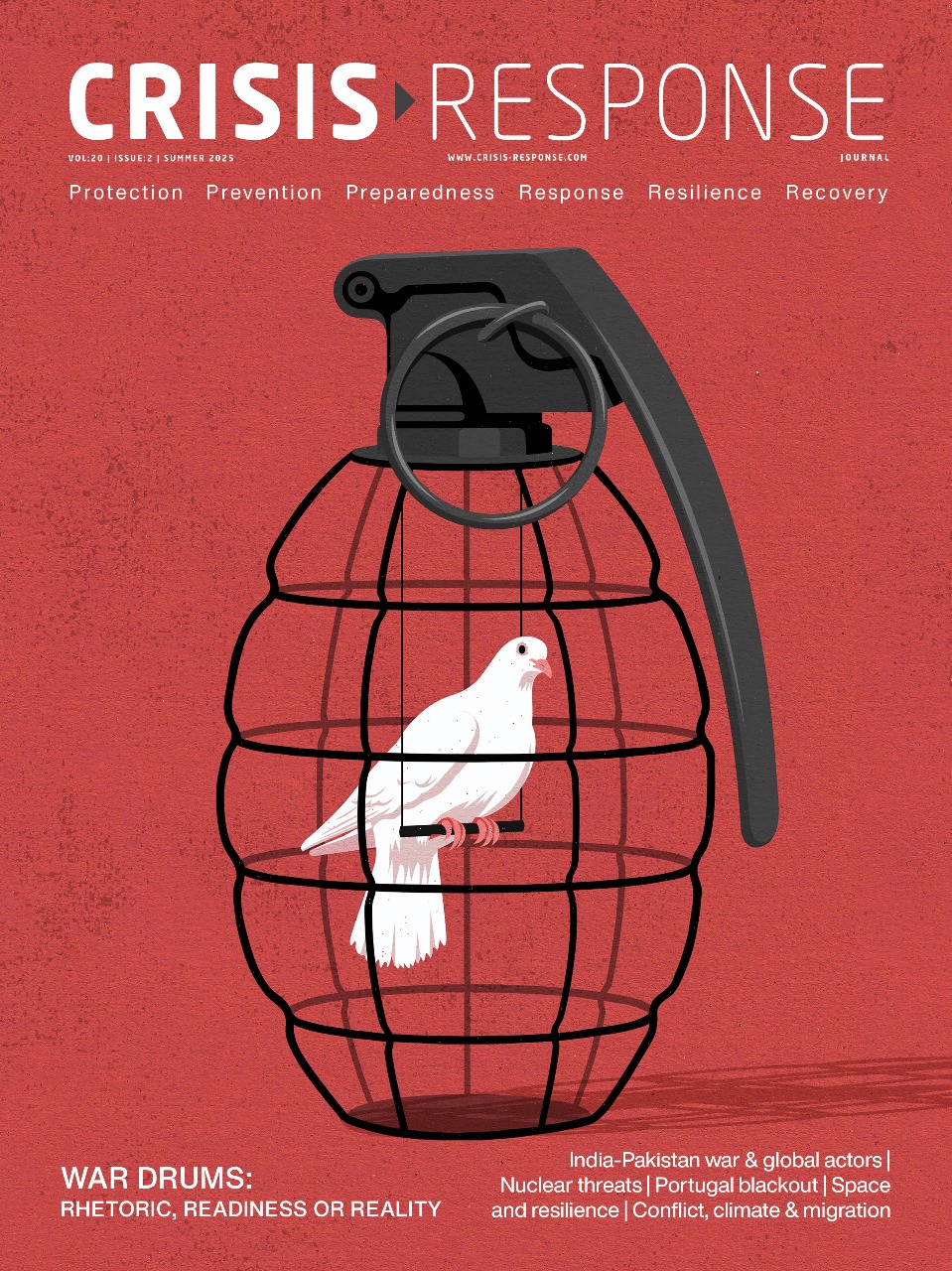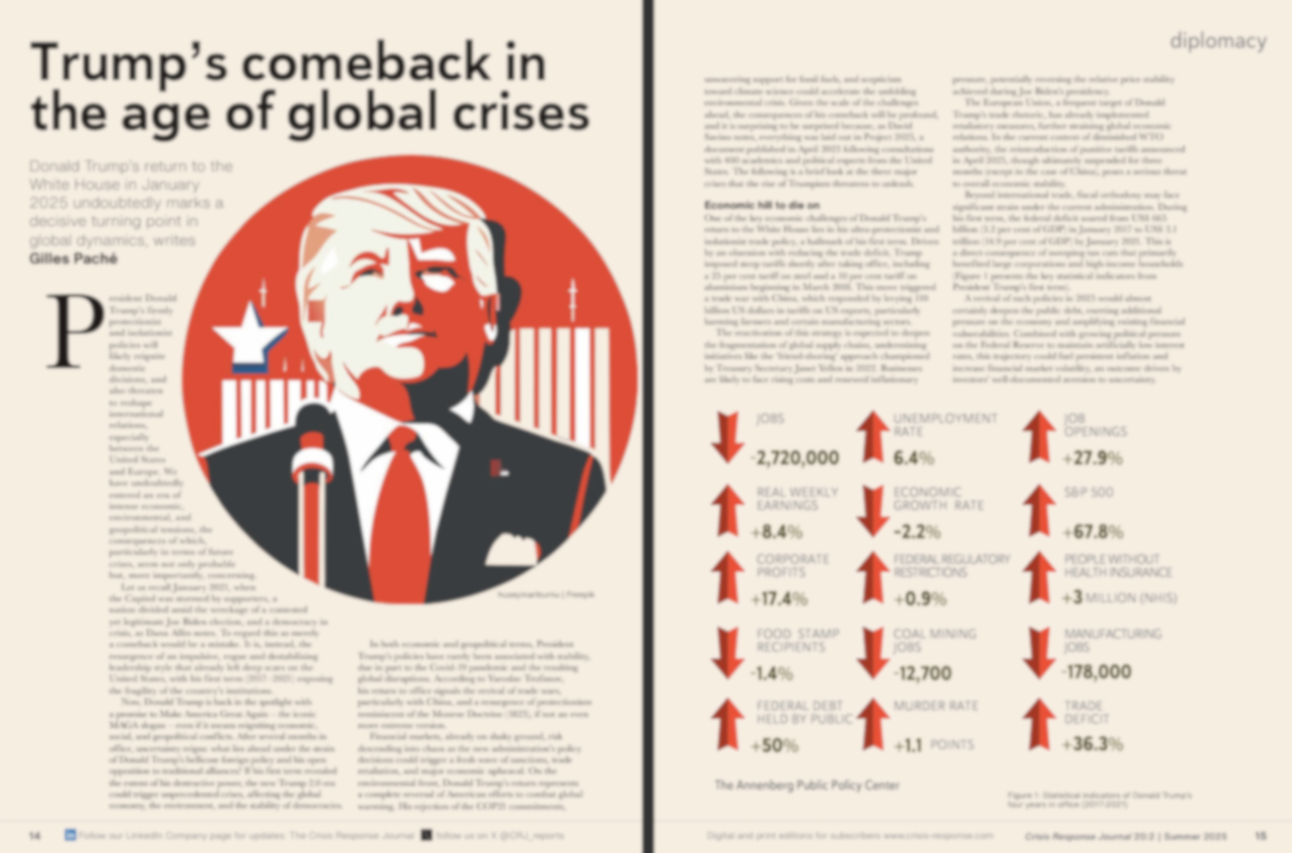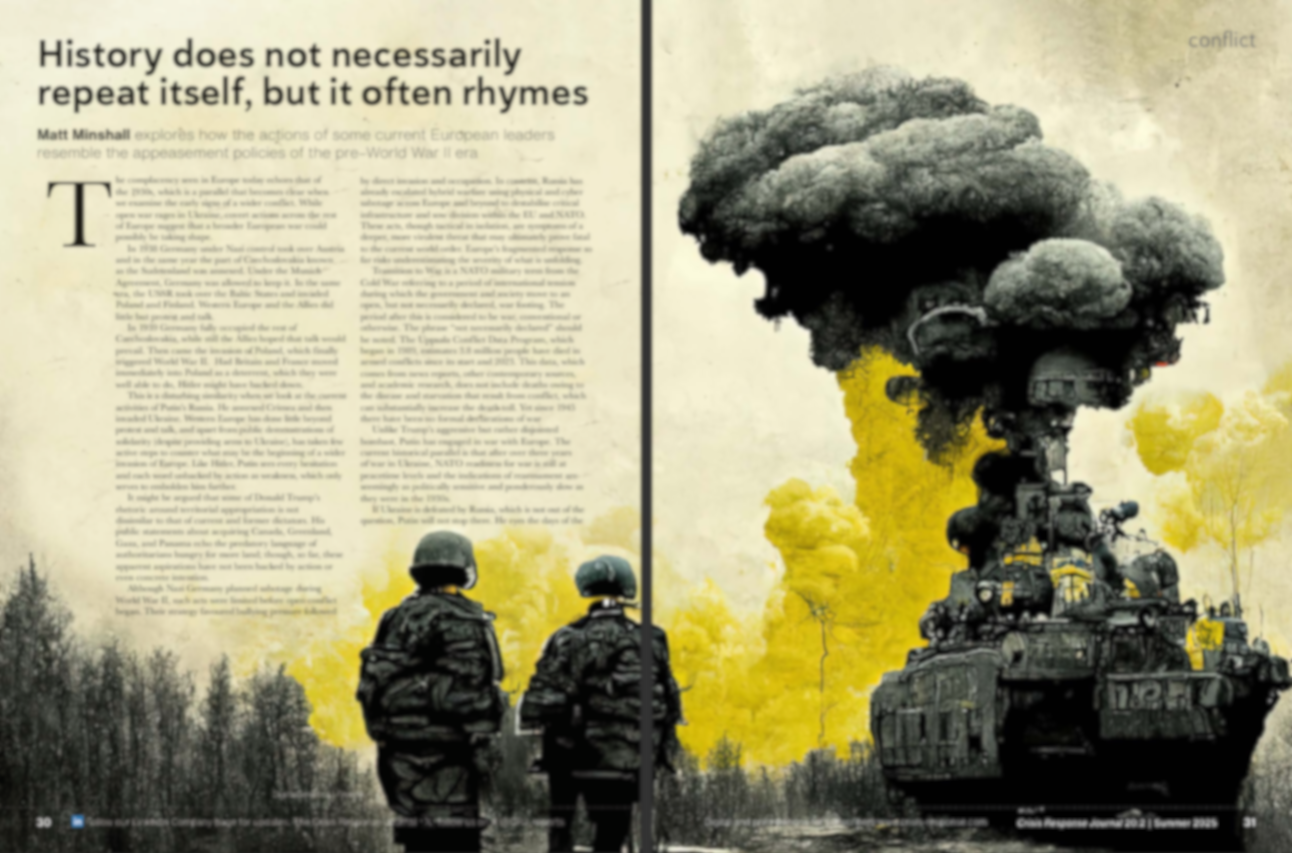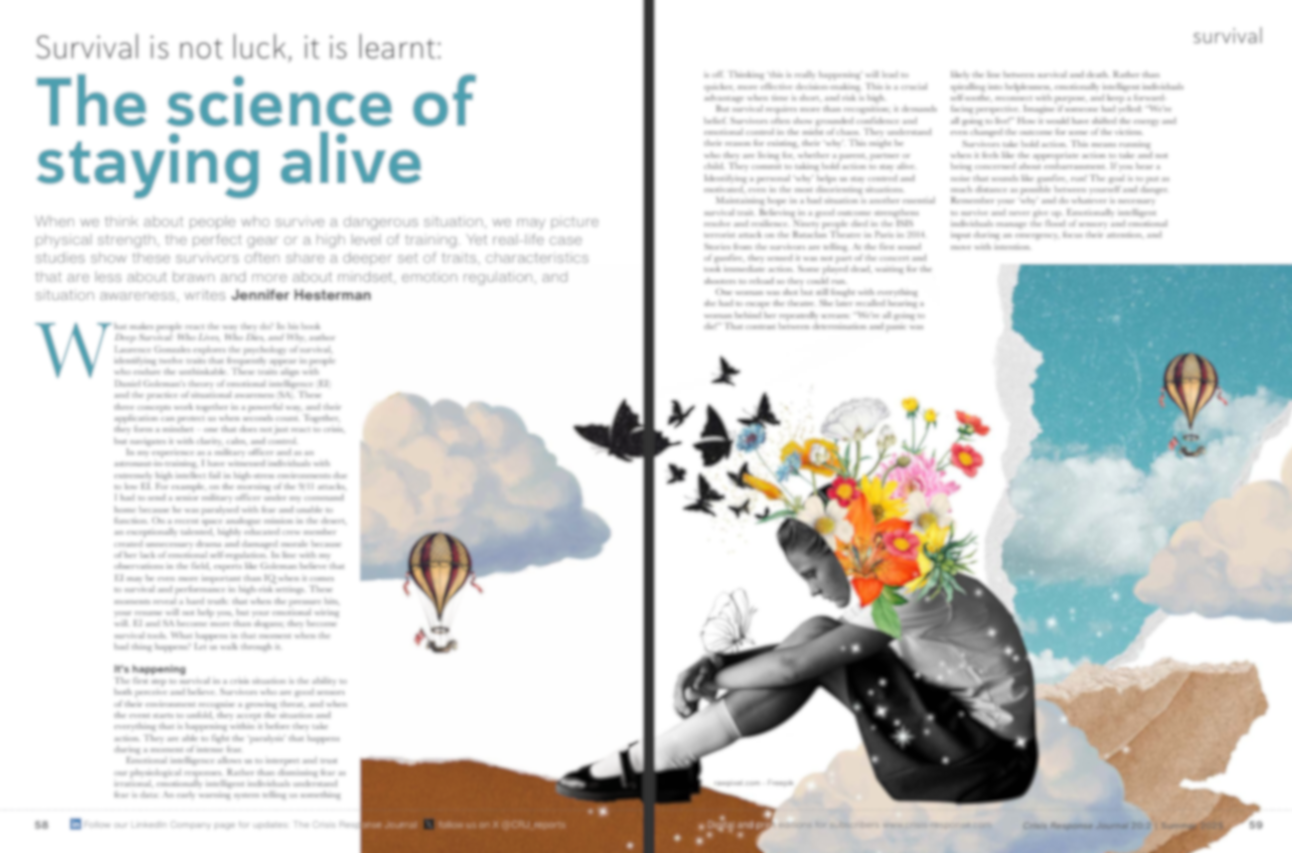CRJ's Summer 2025 edition is out now!
 Our Summer 2025 issue is now live. The digital edition can be accessed on the CRJ website, whereas CRJ 20:2 hard copies will be mailed out shortly.
Our Summer 2025 issue is now live. The digital edition can be accessed on the CRJ website, whereas CRJ 20:2 hard copies will be mailed out shortly.
This edition tackles the theme of war drums, looking at geopolitical tensions and conflicts and their global effects. It also explores the intersection of war, climate change, and migration as well as advancements in technology and AI. Furthermore, it reframes strategies and models in the field of risk management and communication.
Comment: Matthew Porcelli explains that resilience in risk and crisis management must be built proactively, well before a crisis even occurs.
Onto war drums: Gilles Paché takes a look at Donald Trump’s policies and their effects on global dynamics. He writes: “In both economic and geopolitical terms, President Trump’s policies have rarely been associated with stability, due in part to the Covid-19 pandemic and the resulting global disruptions.
Kunwar Khuldune Shahid reports on the recent airstrikes shared between nuclear-armed India and Pakistan. He notes that the conflict has the fingerprints of many global powers, including the US, China, Russia, and Middle Eastern states; some countries used it to test alliances, weapons, and diplomatic influence. In the same vein, Pavel Kiparisov and Christian Folberth warn that the risk of nuclear conflict remains high and rising. Building upon their research, they explain: “In any tested configuration of conflicts, the world would see severe food shortages due to the intricacy of today's global agrifood trade network alone, which renders it highly vulnerable.”

Gilles Pache's piece on p14 looks at global dynamics shifts because of President Trump's policies.
This edition also takes a look at the intersection of conflict, climate and other crises. For instance, Mostafa Sayyadi and Majid Ghazizadeh note that international collaboration and social capital-based organisation reform are needed to resolve issues stemming from migration.
Similarly, Kunwar Khuldune Shahid reports on the relationship between war and climate change in the Middle East. Rising temperatures, water scarcity, and environmental degradation create and worsen conflict in the region simultaneously. Meanwhile, Zainab Farooqui analyses how refugee and migrant populations face the brunt of climate change while adding to environmental degradation in host nations.
Looking back: Roger Gomm shares his experience as the superintendent in the Metropolitan Police Service (MPS) Central Operations during the July 2005 London bombings, which tested the resilience of London’s emergency response framework and the effectiveness of its command structure in managing a complex, fast-moving crisis. Matt Minshall offers another look at history. He revisits European leaders’ complacency before WWII and draws parallels with responses to Russian aggression today.

"Failure to overcome the blindness of complacency will see the rhyming of the appeasement of the 1930s turn into a repetition of the history of the 1940s," writes Matt Minshall (p 30)
Moving into technology, Lina Kolesnikova and Michael Kolatchev review advancements in aerial drones, examining their potential future geopolitical consequences. They note: “In the past, the source of an attack was usually clear, allowing for a calculated and often proportional response. That clarity has eroded. How do you assign blame or justify retaliation when the threat comes in the form of a bee-shaped drone?”
Looking at artificial intelligence, James Rubec explores the use of an AI-driven threat detection and alerting system in academic and corporate settings, while Mostafa Sayyadi and Michael Provitera explain how CEOs can adapt to counter severe disruptions caused by AI.
Critical failures: Nuno Sousa examines the municipal response in Setúbal, Portugal, to a 10-hour blackout across the Iberian Peninsula, which severely disrupted communications, healthcare, and water systems.
Looking at crisis communication and leadership, Philippe Borremans emphasises the need for better, proactive strategies, particularly considering today’s complex emergencies. He adds: “People do not remember your statements; they remember how you made them feel when they were scared or confused. This emotional imprint outlasts any specific content.” Meanwhile, Caroline Field and Grace Rodgers emphasise the need to reframe communication in resilience in order to engage people and empower communities.

Philippe Borremans says: “People do not remember your statements; they remember how you made them feel when they were scared or confused. This emotional imprint outlasts any specific content.” (p 54)
In terms of recovery and response: Dr Abdou Salam Gueye and Charlie Reeves explain how the World Health Organization’s initiatives, such as sub-regional stockpiling, act as a solution to Africa’s public health emergencies, and Lindsay Lowery explores a portable cooling system that can be integrated in facilities for a more respectful and scalable mortuary response plan.
Moreover, Ekaterina Kostioukhina reviews the advancements and applications of human hypometabolism in trauma care, spaceflight, disaster response, and chronic disease treatment. On the other hand, Matt Minshall argues for a shift in perspective, urging societies to see flooding not solely as a destructive force, but as a natural phenomenon with potential ecological and societal benefits when managed wisely.
Moreover, Nicola Lester provides family mediation as a trauma-informed, therapeutic intervention that helps former hostages and their families rebuild relationships and communication post-release.
Similarly, Jennifer Hesterman explores how emotional intelligence, situational awareness, and a survivor mindset are critical to enduring crises. She says: “Survivors do not wait to be rescued; they rescue themselves. Their ability to overcome paralysis is due to preparatory activities such as analysing the situation and planning a response.”

Jennifer Hesterman's piece (p 58)
Similarly, Rebecca Scorzato and Andrew Torres explain how organisations can enhance crisis management by integrating employee-focused disaster relief programmes that align with the company's values and improve resilience. On the other hand, Jeannie Barr emphasises that with the current global instability and uncertainty, resilience professionals should shift their perspective towards civil defence by adopting a ‘whole-of-society’ approach.
Furthermore, Igor Milic discusses how vocational education and training are essential for developing the skills needed to improve crisis management and resilience in today’s complex security environment, while Valentin Forand highlights a gamification tool to teach risks to children.
Kelly Blakeley explores the future of resilience in an AI-driven world. She says that AI mimics how we see the world; we are its knowledge infrastructure, which means that: “The future of crisis readiness won’t just be faster. It will be more complex, more collaborative and more human – if we design it that way.”
This edition also puts the spotlight on re-education in risk management and practice. Dr Chris Needham-Bennett and Iman Chaudhry review a used risk matrix. They add: “It soon becomes apparent that the formula’s prominence in mainstream risk management lacks academic validity, standing only on its persistent reuse.” Cedrick Moriggi offers a different perspective. He argues that true resilience isn't quantifiable or captured by risk models; it stems from human adaptability, relationships, leadership, and emotional strength.
Gianluca Pescaroli urges organisations to opt for a risk-agnostic approach that focuses on identifying system vulnerabilities and stress-testing resilience, rather than relying on traditional risk models in the context of high-impact low-probability (HILP) events.
Frontline: Zainab Farooqui speaks to Kelly Ramsey about her experiences as the only woman on her firefighting crew. Ramsey emphasises: “More women in the field would make it easier on all women present and would make the profession healthier and more sustainable.”
The Blue Light Show launches this year in the UK, created in response to increasing demand for a sector-wide event that unites the police, fire and rescue, ambulance, coastguard, and search and rescue services in the capital. To register for free, please visit: www.bluelight.show
Brian Wagner explores his book Redefining Information Security: How to Build a Security-Driven Organisation, which breaks down fundamental principles and approaches to embedding security into operations.
The Crisis Response Journal is available to subscribers only – we have a range of subscription rates to suit all needs. Click here for more details or contact us at hello@crisis-response.com – we would love to hear from you!